-
项目名称
- 福建省高校杰出青年科研人才培育计划(2017);福建师范大学大学生创新创业基金“福建师范大学2021年国家级大学生创新创业训练计划”(202110394021)
-
第一作者简介
- 邱思慧(2000—),女,本科生。主要研究方向:生态与环境。E-mail: qsh012520@163.com
-
通信作者简介
- 王维奇(1982—),男,博士,研究员。主要研究方向:生态与环境。E-mail: wangweiqi15@163.com
-
文章历史
-
收稿日期:2021-02-04
修回日期:2022-02-26
土壤有机碳在生态系统碳循环过程中扮演着重要角色,其储量与分布特征受物种组成、土壤性质、环境因素等共同作用,不同区域有机碳分布格局的主导影响因子也有所差异。近年来,关于土壤有机碳的研究虽然已取得了一些成果,但是基于不同海拔视角,探讨其含量、组分及影响因子的研究尚鲜见报道。
从已有研究进展来看,就气候带而言,研究区域集中在温带森林,针对亚热带地区不同海拔土壤有机碳的研究虽然也开展了一些研究,但相对较少[1];在研究方法上,有以自然海拔条件为切入点[2],也有通过室内模拟的研究[3];从生态系统类型来看,主要研究森林生态系统有机碳含量随海拔梯度的变化[4],对草原、茶园等生态系统研究较少;从研究内容来看,研究的主要指标集中在有机碳组分和含量、土壤水分等理化性质[5];而从环境影响因子来看,不同区域研究结果中影响有机碳分布主导因子也有所差异。从不同视角而言,当前研究进展主要表现为不同海拔梯度条件下,土壤有机碳库含量和土壤矿化速率与海拔呈现一定程度的正相关性,其中土壤温度、水分、土壤类型以及动植物组分等因素的差异是影响土壤有机碳库含量的主要因素,但其在不同气候区域的影响与机制并不相同,因此亟待作以综合分析,为科学解析其内在原因奠定基础。
针对当前研究的匮乏以及不确定性,笔者聚焦不同海拔条件下各因子影响机制及有机碳含量特征关系,主要针对我国东部地区不同海拔梯度土壤碳库分布特征及其影响因子的研究成果及进展作综述,并对未来相关领域的研究提出几点展望,以期为不同海拔梯度有机碳库变化及其机理研究提供理论参考,对不同海拔土壤碳库管理以及通过有机碳积累促进土壤团聚体组成优化及其水土保持效应的提升均具有重要的实践价值。
1 海拔对土壤有机碳库及其组分的影响在不同生态系统中,土壤有机碳库的动态变化特征均会受到环境中多种生物与非生物因素的共同作用。在不同海拔梯度条件下,海拔梯度的改变会影响土壤理化性质(温度、土壤水分)、土壤中动植物、土壤酶、微生物等因子,从而使土壤有机碳含量、有机碳矿化速率及其组分差异发生相应的规律性应答,并进一步反馈于土壤有机碳库改变(图 1)。
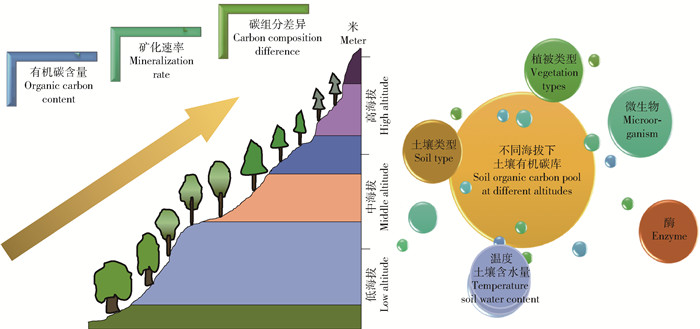
|
图 1 海拔对土壤有机碳库的影响概念图 Fig. 1 Conceptual diagram of the effects of altitude on soil organic carbon pools |
影响土壤有机碳库含量的相关因素中海拔是最重要的影响因素之一[6],通过线性回归分析表明海拔与土壤有机碳含量之间拟合程度高[7-23] (R2=0.174, P < 0.01, 图 2),随着海拔的升高土壤有机碳库含量也逐渐增加。在不同学者的研究中也得出了详实的研究结论,肖霜霜等[7]研究表明有机碳含量在不同海拔分布的土壤类型上表现为高山草甸土>山地黄壤>山地黄红壤>山地红壤,这与土壤中有机碳的累积量与有机质输入及转化速率有关,在高海拔地区,常年处于低温条件,不利于土壤微生物生存,导致土壤的呼吸代谢作用减弱,有利于土壤有机碳的积累[8];另外,不同海拔地区的植被类型各不相同,导致土壤中所残留的凋落物特性存在显著差异,从而改变土壤有机碳库的含量。除此之外,不同土层土壤有机碳含量对海拔的响应程度也不尽相同,有学者研究显示,随着海拔梯度的增加上层土壤(0~40 cm)有机碳含量逐渐增加,下层土壤(40~100 cm)有机碳含量则减少[9]。
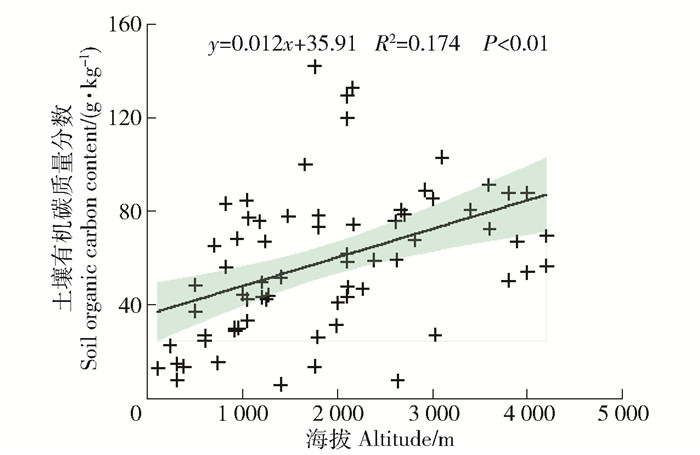
|
图 2 土壤有机碳质量分数随海拔变化线性拟合图(数据来源于参考文献[7-23]) Fig. 2 Linear fitting graph of soil organic carbon content with altitude (Data comes from reference 7-23) |
土壤碳组分的差异与海拔的改变存在显著相关性[24],其影响因子因地理位置的异质性而有所差异。一方面,海拔通过影响烷基碳、烷基碳与烷氧碳的比值以及缩醛碳来改变土壤有机碳组分[25],这与其他学者的研究观点相似,即认为烷基碳和芳香碳2种组分可以体现出土壤有机碳组分的差异[26];其次,刘杨等[5]研究发现不同海拔梯度土壤有机碳含量随着土壤粒级的减小呈现出先升高后降低的趋势;海拔与生物累积量也存在一定程度的相关性,康成芳等[11]研究发现土壤上层的微生物量碳显著高于下层,而土壤可溶性有机碳含量在海拔方面差异不显著。总而言之,土壤碳组分的动态变化特征与生物累积量、土壤理化性质以及植被类型等因素密切相关,是多种环境因素共同作用的结果。
2 海拔对土壤有机碳矿化过程的影响不同海拔条件下影响土壤碳矿化的原因很多,康成芳等[11]研究表明在夏季各海拔土壤碳矿化速率较高,这与参与有机碳矿化分解过程的土壤动物、微生物、凋落物性质、温度等生物或非生物因素的差异有关[27]。在不同海拔区域土壤的矿化实验中发现,高海拔区域土壤的矿化速率较高(图 3和4),在0~10 cm土层2 100 m的土壤有机碳矿化速率相比于1 200 m显著提高80%(P < 0.05),这是因为高海拔土壤含有较多的有机碳,使得土壤矿化过程有充足的反应底物,是一种高输入-高输出-高固持的碳保持模式。在不同土层的土壤中,有机碳矿化过程的响应机制也不尽相同。周焱等[1]研究表明,土壤碳矿化速率与土壤深度的增加呈现显著负相关,土壤表层的有机碳的矿化速率比较容易受到海拔变化的影响。
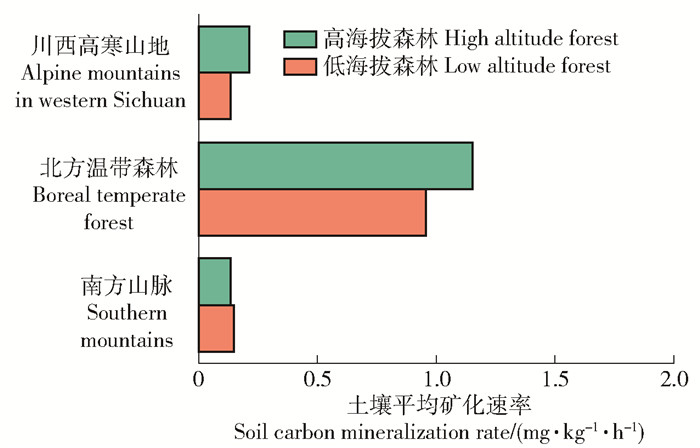
|
图 3 不同区域土壤平均矿化速率(数据来源于[11, 24, 27]) Fig. 3 Average soil mineralization rate in different regions (Data from [11, 24, and 27]) |
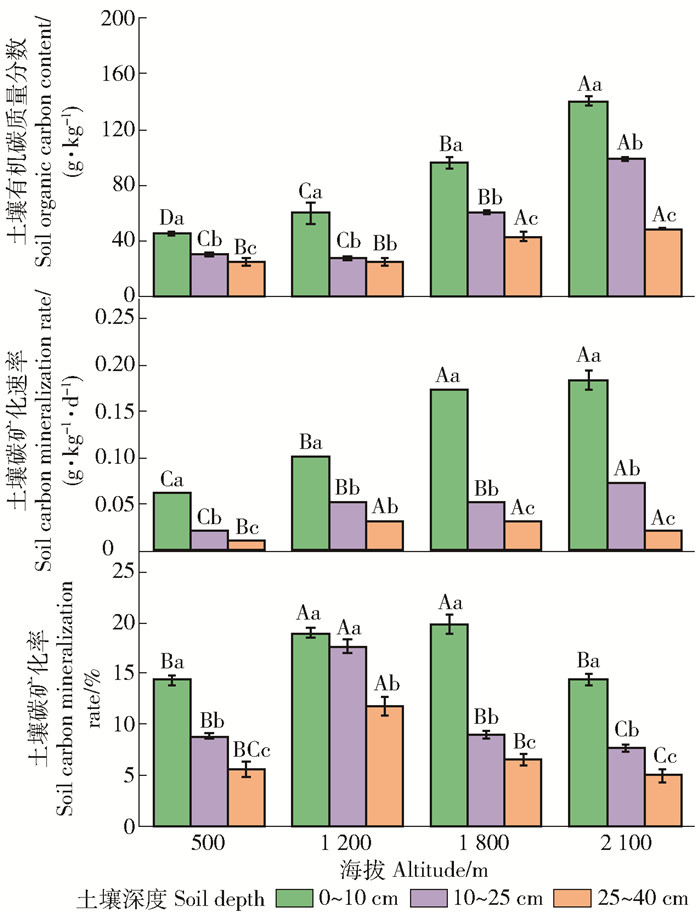
|
图中大写字母A、B、C表示不同海拔条件下差异达显著性水平(P < 0.05),小写字母a、b、c表示同一海拔条件下不同土层间差异达显著性水平(P < 0.05),数据来源于参考文献[1] The uppercase letters A, B, and C in the figure indicate that the differences reached a significant level under different altitude conditions (P < 0.05), and the lowercase letters a, b, and c indicate that the differences between different soil layers under the same altitude reached a significant level (P < 0.05), the data comes from reference [1] 图 4 不同海拔土壤有机碳库变化特征 Fig. 4 Variation characteristics of soil organic carbon pool at different altitudes |
土壤中有机碳的输入和输出过程对土壤有机碳含量具有显著性影响。其中海拔梯度的改变直接或间接引起土壤类型、土壤酶、植被类型、土壤温度、湿度等环境因素发生变化,叠加土壤深度的差异,进一步反馈于土壤理化性质以及生物、物理、化学过程,从而进一步影响碳循环、水土保持效应与全球生态系统的平衡与稳定(图 5)。在不同海拔条件下温度、植被类型、土壤酶、土壤含水量、土壤微生物和土壤类型是最基本的,也是十分重要的影响因子,对正确合理解释不同海拔土壤有机碳库变化特征具有普适性,因此对以上6种因素进行综述。
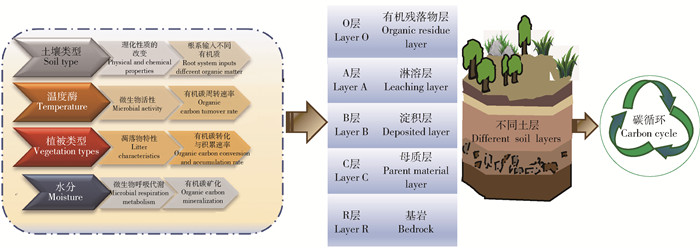
|
图 5 不同海拔有机碳库影响因子 Fig. 5 Effect factors of organic carbon pool at different altitudes |
温度对不同海拔土壤有机碳含量的影响机制因环境因子、所处地理位置的变化存在显著差异性。一方面,Ladd等[28]研究发现升温会加快土壤有机质的分解速度,温度的上升会带来土壤有机质的损失[29];温度升高引起土壤碳矿化速率增加的主要原因是微生物种类与数量的增加产生更多参与有机碳分解矿化的酶系;另一方面,温度引起土壤有机碳库动态变化使土壤微生物的分解过程受到影响;此外,温度与土壤有机碳间存在复杂的反馈机制,在特定的环境条件下表现为正反馈,或者表现为负反馈[30]。黄耀等[31]研究显示土壤有机碳随温度的变化存在一个阀值,具体表现为在土壤温度较低时,升温会促进土壤有机碳的分解,但随着温度的升高,这种促进作用会逐渐降低。通过温度和土壤有机碳含量的线性回归分析(图 6a),温度与土壤有机碳之间的拟合程度相对较低,表明海拔间接地影响温度因子,从而在一定程度上会改变土壤有机碳矿化速率,但温度对土壤有机碳库的影响仍具复杂性和诸多不确定性。
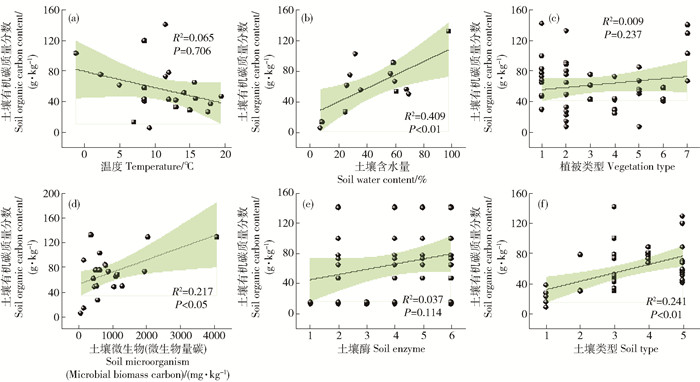
|
图6(c)中,将阔叶林、针叶林、针阔混交林、灌林地、灌丛草甸、亚山草甸、高山草甸分别赋值为1、2、3、4、5、6、7;图6(e)中,将蛋白酶、过氧化氢酶、磷酸酶、脲酶、酸性磷酸酶、蔗糖酶分别赋值为1、2、3、4、5、6;图6(f)中,将山地红壤、山地黄红壤、山地黄壤、山地暗棕壤、山地草甸土分别赋值为1、2、3、4、5 (数据来源于参考文献[11-24]) In Figure 6(c), the broad-leaved forest, coniferous forest, coniferous and broad-leaved mixed forest, shrub woodland, shrub meadow, sub-mountain meadow, and alpine meadow are assigned the value 1, 2, 3, 4, 5, 6, and 7 respectively. In Figure 6(e), the protease, catalase, phosphatase, urease, acid phosphatase, and invertase are assigned value1, 2, 3, 4, 5, and 6, respectively. In Figure 6(f), the mountain red soil and the mountain yellow red soil, mountain yellow soil, mountain dark brown soil, and mountain meadow soil are assigned value of 1, 2, 3, 4, and 5 respectively (data from references [11-24]) 图 6 土壤有机碳质量分数随温度、土壤含水量、植被类型、土壤微生物、土壤酶和土壤类型变化线性拟合图 Fig. 6 Linear fitting graph of changes in soil organic carbon content with temperature, soil water content, vegetation type, soil microorganisms, soil enzymes and soil types |
土壤含水量和有机碳含量的相关研究表明(图 6b),土壤含水量与有机碳含量之间存在极显著相关性(R2=0.409, P < 0.01),首先,土壤含水量与有机碳的矿化过程有相关;其次,不同海拔土壤水分含量的差异对土壤团聚体有一定影响,从而进一步影响土壤有机碳库的积累与转化过程;最后,水分对有机碳库的影响往往还伴随着其他因素的综合作用。其中,土壤水分的改变会在一定程度上改变土壤碳库含量,但有机碳的动态变化不仅仅是水分单方面环境因素的影响,更多的是多种环境因素相互作用的结果[32]。土壤水分对微生物量碳及微生物活性有显著影响,从而进一步影响不同海拔及不同土层有机碳的分解[33-34];也有学者发现,在特定条件下土壤水分的增加,会促进土壤微生物对DOC的分解利用,增强参与有机碳矿化过程的微生物活性,进而加快土壤有机碳积累与转化过程[35]。此外,土壤水分的改变往往影响着土壤团聚体、土壤动植物生物化学等进程,从而直接作用于土壤有机碳库。
3.3 植被类型施政等[23]研究发现植物进入土壤后,新鲜有机物的种类及数量特征的差异会影响土壤有机物质的含量;已有研究发现,草地的土壤微生物增长量明显高于耕地和林地[36],这是因为草本植物细根系发达,大部分聚集在土壤表层,而微生物的能源物质主要来源于根系分泌物和植物根残体。与此同时,植被类型的不同导致凋落物特性的差异,在一定程度上会改变土壤微生物群落特征,且微生物量和土壤碳利用效率均与植被类型密切相关。刘伟等[37]对黄土高原草地类型的土壤有机碳含量进行研究发现的土壤有机碳主要分布在土壤表层,与海拔在一定程度上呈显著正相关。张彦军等[38]研究发现太白山北坡上的土壤有机碳密度由于植被带的不同而差异明显。尽管已有的研究中,植被类型的影响已得到认知,但其正反馈还是负反馈仍存在不确定性,相关研究(图 6c)表明,不同海拔条件下植被类型与有机碳之间相关性较低(P=0.237),也印证了植被类型与土壤有机碳之间的复杂性,说明虽然植被类型的差异会带来凋落物、植物残体和生物归还量等的差异,进一步改变土壤有机碳的空间分布和积累状况[39-40],但植被类型的改变并不是直接驱动土壤有机碳库含量改变的因子。
3.4 土壤微生物土壤生物中最活跃的组成部分是土壤微生物,它广泛地参与到土壤有机质的分解矿化和土壤养分转化等过程,是影响土壤有机碳库含量的一个重要因子。李君剑等[12]研究发现土壤中细菌、真菌、放线菌等微生物的数量随着海拔的升高显著降低,微生物的数量与海拔呈现显著负相关,这是因为高海拔低温条件会抑制土壤微生物的新陈代谢活动,导致土壤微生物数量减少,抑制土壤微生物活性,使土壤碳矿化速率变慢[41],此外,土壤微生物和有机碳含量存在显著相关性(R2=0.217, P < 0.05, 图 6d),这进一步证明了不同海拔条件下土壤微生物的新陈代谢过程特性及其数量都与土壤有机碳含量的动态变化特征息息相关[42]。
3.5 土壤酶土壤有机碳的矿化分解过程是十分重要的生物化学变化过程,而土壤酶有促进有机碳分解转化的作用,是土壤有机碳分解矿化的驱动者[38]。土壤中的动植物和微生物的分泌物及其残体是土壤酶的主要来源。土壤酶活性与海拔因素具有显著相关性,随着海拔升高土壤酶活性也相应的增加。聂阳意等[27]研究发现,高海拔地区的土壤酶活性显著高于低海拔区域的酶活性,这是因为高海拔地区的动植物及微生物的种类和数量复杂,并且当海拔较高时有利于土壤微生物分解土壤有机碳,而酶活性的升高会进一步加快土壤有机碳库的分解与转化过程,进而改变不同海拔条件下土壤有机碳库的累积量。
3.6 土壤类型不同海拔土壤成土过程、理化性质等差异将导致土壤有机碳含量发生改变。通过对土壤类型进行线性回归拟合分析发现(图 6f),土壤类型与有机碳含量间拟合程度高,相关性显著(R2=0.241, P < 0.01)。一方面,吴小刚等[9]研究结果显示,分布在海拔较高处的山地草甸土,其土壤有机碳含量明显高于低海拔的土壤,这与薛丽佳等[42]对武夷山不同类型土壤有机碳含量分布的结果一致,另一方面,土壤类型的差别会导致土壤质地和土壤团聚体组成的差异,如活性有机碳库和缓效性有机碳库含量与土壤质地密切相关,即当土壤中的砂性成分低、黏土成分较高时,土壤碳稳定性增加,这是因为黏粒对有机碳具有保护作用。
4 结论1) 土壤有机碳含量与海拔呈现正相关,有机碳化学组分在不同海拔条件下也存在一定差异性;在同一海拔条件下,上层土壤有机碳含量比下层土壤有机碳含量高。
2) 土壤有机碳矿化程度随海拔的升高而增加,同一海拔不同土层中,土壤碳矿化速率随土层加深而递减。
3) 不同海拔条件下,土壤含水量、土壤微生物、土壤类型是影响土壤有机碳库的主要因素。
5 展望不同海拔条件下土壤有机碳库的影响因素随着地形、环境因子的改变而改变。尽管不同海拔条件下不同影响因子的组合能在一定程度上解释有机碳分布特征的变异性,但仍有部分变异原因尚未知晓,其响应机理尚存争议。新技术应用的单一性,研究思路的专一性都限制着明晰海拔对土壤有机碳变化影响的科学认知。基于此,为更好地以科学问题为导向,解决研究领域中的瓶颈问题,在未来的研究中以下几方面亟待加强:1)在研究内容上,目前着重于探究单因素对不同海拔梯度碳库的影响机制,对于多因子交互作用的影响研究较为欠缺,亟需加强多因子组合对不同海拔土壤有机碳库形成过程及机制的影响研究;2)在研究应用价值上,土壤有机碳与土壤团聚体的形成与稳定密切相关,而土壤团聚体结构稳定性又是调节着土壤水土保持效应的关键所在,特别是在山地丘陵区,开展不同海拔梯度的土壤有机碳累积特征、团聚体形成与稳定机制,探讨海拔梯度尺度上的碳的迁移与水土保持效应的综合研究,并辨识其内在联系,对土壤生态功能的维持、水土保持研究与健康土壤的管理均具有重要的现实价值。
| [1] |
周焱, 徐宪根, 阮宏华, 等. 武夷山不同海拔高度土壤有机碳矿化速率的比较[J]. 生态学杂志, 2008, 27(11): 1901. ZHOU Yan, XU Xiangen, RUAN Honghua, et al. Comparison of soil organic carbon mineralization rate at different altitudes in Wuyi Mountain[J]. Chinese Journal of Ecology, 2008, 27(11): 1901. |
| [2] |
吴则焰, 林文雄, 陈志芳, 等. 武夷山国家自然保护区不同植被类型土壤微生物群落特征[J]. 应用生态学报, 2013, 24(8): 2301. WU Zeyan, LIN Wenxiong, CHEN Zhifang, et al. Characteristics of soil microbial communities in different vegetation types in Wuyishan National Nature Reserve[J]. Chinese Journal of Applied Ecology, 2013, 24(8): 2301. |
| [3] |
BU Xiaoli, RUAN Honghua, WANG Liming, et al. Soil organic matter in density fractions as related to vegetation changes along an altitude gradient in the Wuyi Mountains, southeastern China[J]. Applied Soil Ecology, 2011(52): 42. |
| [4] |
吴雅琼, 刘国华, 傅伯杰, 等. 森林生态系统土壤CO2释放随海拔梯度的变化及其影响因素[J]. 生态学报, 2007, 27(11): 4678. WU Yaqiong, LIU Guohua, FU Bojie, et al. Changes in soil CO2 release of forest ecosystems with altitude gradients and their impacts[J]. Acta Ecologica Sinica, 2007, 27(11): 4678. DOI:10.3321/j.issn:1000-0933.2007.11.036 |
| [5] |
刘杨, 李菊, 孙辉, 等. 海拔梯度上川西高山土壤有机碳稳定性研究[J]. 水土保持研究, 2020, 27(2): 123. LIU Yang, LI Ju, SUN Hui, et al. Study on the stability of alpine soil organic carbon in West Sichuan on altitude gradient[J]. Research of Soil and Water Conservation, 2020, 27(2): 123. |
| [6] |
TSUI C C, TSAI C C, CHEN Z S. Soil organic carbon stocks in relation to elevation gradients in volcanic ash soils of Taiwan[J]. Geoderma, 2013, S209/210(11): 119. |
| [7] |
肖霜霜, 陈武荣, 许燕萍, 等. 武夷山山地土壤有机碳的垂直分布规律及影响因素研究[J]. 安徽农学通报, 2008, 14(11): 65. XIAO Shuangshuang, CHEN Wurong, XU Yanping, et al. Study on the vertical distribution law and influencing factors of soil organic carbon in Wuyi Mountain[J]. Anhui Agricultural Science Bulletin, 2008, 14(11): 65. |
| [8] |
程浩, 张厚喜, 黄智军, 等. 武夷山不同海拔高度土壤有机碳含量变化特征[J]. 森林与环境学报, 2018, 38(2): 135. CHENG Hao, ZHANG Houxi, HUANG Zhijun, et al. Variation characteristics of soil organic carbon content at different altitudes in Wuyi Mountain[J]. Journal of Forest and Environment, 2018, 38(2): 135. |
| [9] |
吴小刚, 王文平, 李斌, 等. 中亚热带森林土壤有机碳的海拔梯度变化[J]. 土壤学报, 2020, 57(6): 1539. WU Xiaogang, WANG Wenping, LI Bin, et al. Altitude gradient changes in soil organic carbon in mid-subtropical forests[J]. Acta Pedologica Sinica, 2020, 57(6): 1539. |
| [10] |
TASHI S, SINGH B, KEITEL C, et al. Soil carbon and nitrogen stocks in forests along an altitudinal gradient in the eastern Himalayas and a meta-analysis of global data[J]. Global Change Biology, 2016, 22(6): 2255. DOI:10.1111/gcb.13234 |
| [11] |
康成芳, 宫渊波, 车明轩, 等. 川西高寒山地灌丛草甸不同海拔土壤有机碳矿化的季节动态[J]. 生态学报, 2020, 40(4): 1367. KANG Chengfang, GONG Yuanbo, CHE Mingxun, et al. Seasonal dynamics of soil organic carbon mineralization at different altitudes in the alpine mountainous shrub meadow of western Sichuan[J]. Acta Ecologica Sinica, 2020, 40(4): 1367. |
| [12] |
李君剑, 杜宏宇, 刘菊, 等. 光帝山不同海拔土壤碳矿化和微生物特征[J]. 中国环境科学, 2018, 38(5): 1811. LI Junjian, DU Hongyu, LIU Ju, et al. Soil carbon mineralization and microbial characteristics at different altitudes in Guangdi Mountain[J]. China Environmental Science, 2018, 38(5): 1811. |
| [13] |
李聪, 吕晶花, 陆梅, 等. 滇东南典型常绿阔叶林土壤酶活性的海拔梯度特征[J]. 林业科学研究, 2020, 33(6): 170. LI Cong, LV Jinghua, LU Mei, et al. Altitude gradient characteristics of soil enzyme activities in typical evergreen broad-leaved forests in southeastern Yunnan[J]. Forestry Science Research, 2020, 33(6): 170. |
| [14] |
黄桥明, 吕茂奎, 聂阳意, 等. 武夷山不同海拔森林表层土壤轻组有机质特征[J]. 生态学报, 2020, 40(17): 6215. HUANG Qiaoming, LV Maokui, NIE Yangyi, et al. Characteristics of organic matter of light group of topsoil in forests at different altitudes in Wuyi Mountain[J]. Acta Ecologica Sinica, 2020, 40(17): 6215. |
| [15] |
苟天雄, 刘韩, 帅伟, 等. 川西高寒山地不同海拔高度土壤团聚体特征[J]. 水土保持研究, 2020, 27(1): 47. GOU Tianxiong, LIU Han, SHUAI Wei, et al. Characteristics of soil aggregates at different altitudes in the Alpine Mountains of western Sichuan[J]. Research on Soil and Water Conservation, 2020, 27(1): 47. |
| [16] |
许恩兰, 林雪婷, 郭剑芬. 水分对武夷山不同海拔土壤有机碳矿化的影响[J]. 亚热带资源与环境学报, 2019, 14(1): 30. XU Enlan, LIN Xueting, GUO Jianfen. Effects of water on soil organic carbon mineralization at different altitudes in Wuyi Mountain[J]. Journal of Subtropical Resources and Environment, 2019, 14(1): 30. |
| [17] |
曹瑞, 吴福忠, 杨万勤, 等. 海拔对高山峡谷区土壤微生物生物量和酶活性的影响[J]. 应用生态学报, 2016, 27(4): 1257. CAO Rui, WU Fuzhong, YANG Wanqin, et al. Effects of altitude on soil microbial biomass and enzyme activities in alpine valleys[J]. Chinese Journal of Applied Ecology, 2016, 27(4): 1257. |
| [18] |
王宁, 杨雪, 李世兰, 等. 不同海拔红松混交林土壤微生物量碳、氮的生长季动态[J]. 林业科学, 2016, 52(1): 150. WANG Ning, YANG Xue, LI Shilan, et al. Growth season dynamics of soil microbial biomass carbon and nitrogen in mixed forests of Korean pine at different altitudes[J]. Forestry Science, 2016, 52(1): 150. |
| [19] |
朱凌宇, 潘剑君, 张威. 祁连山不同海拔土壤有机碳库及分解特征研究[J]. 环境科学, 2013, 34(2): 668. ZHU Lingyu, PAN Jianjun, ZHANG Wei. Study on soil organic carbon pool and decomposition characteristics at different altitudes in Qilian Mountains[J]. Environmental Science, 2013, 34(2): 668. |
| [20] |
郭剑芬, 陈玲, 林雪婷, 等. 温度对武夷山不同海拔土壤有机碳矿化的影响[J]. 亚热带资源与环境学报, 2012, 7(3): 1. GUO Jianfen, CHEN Ling, LIN Xueting, et al. Effects of temperature on soil organic carbon mineralization at different altitudes in Wuyi Mountain[J]. Journal of Subtropical Resources and Environment, 2012, 7(3): 1. |
| [21] |
刘秉儒. 贺兰山东坡典型植物群落土壤微生物量碳、氮沿海拔梯度的变化特征[J]. 生态环境学报, 2010, 19(4): 883. LIU Bingru. Variation characteristics of soil microbial biomass carbon and nitrogen along altitude gradients in typical plant communities on the eastern slope of Helan Mountain[J]. Chinese Journal of Ecoenvironment, 2010, 19(4): 883. |
| [22] |
何容, 王国兵, 汪家社, 等. 武夷山不同海拔植被土壤微生物量的季节动态及主要影响因子[J]. 生态学杂志, 2009, 28(3): 394. HE Rong, WANG Guobing, WANG Jiashe, et al. Seasonal dynamics and main influencing factors of soil microbial biomass of vegetation at different altitudes in Wuyi Mountain[J]. Chinese Journal of Ecology, 2009, 28(3): 394. |
| [23] |
施政, 汪家社, 何容, 等. 武夷山不同海拔土壤呼吸及其主要调控因子[J]. 生态学杂志, 2008, 27(4): 563. SHI Zheng, WANG Jiashe, HE Rong, et al. Soil respiration at different altitudes in Wuyi Mountain and its main regulating factors[J]. Chinese Journal of Ecology, 2008, 27(4): 563. |
| [24] |
樊金娟, 李丹丹, 张心昱, 等. 北方温带森林不同海拔梯度土壤碳矿化速率及酶动力学参数温度敏感性[J]. 应用生态学报, 2016, 27(1): 17. FAN Jinjuan, LI Dandan, ZHANG Xinyu, et al. Soil carbon mineralization rate and temperature sensitivity of enzyme kinetic parameters at different altitude gradients in northern temperate forests[J]. Chinese Journal of Applied Ecology, 2016, 27(1): 17. |
| [25] |
DERESSA A. Effects of soil moisture and temperature on carbon and nitrogen mineralization in grass land soils fertilized with improved cattle slurry manure with and without manure additive[J]. Journal of Environment & Human, 2015(2): 1. |
| [26] |
BOENI M, BAYE R C, DIECKOW J, et al. Organic matter composition in density fractions of Cerrado Ferralsols as revealed by CpMAS13C NM: Influence of pastureland, crop land and integrated crop-livestock[J]. Agriculture Ecosystems & Environment, 2014, 190: 80. |
| [27] |
聂阳意, 王海华, 李晓杰, 等. 武夷山低海拔和高海拔森林土壤有机碳的矿化特征[J]. 应用生态学报, 2018, 29(3): 748. NIE Yangyi, WANG Haihua, LI Xiaojie, et al. Mineralization characteristics of forest soil organic carbon in low and high altitudes in Wuyi Mountain[J]. The Journal of Applied Ecology, 2018, 29(3): 748. |
| [28] |
LADD J N, OADES J M, AMATO M. Microbial biomass formed from14C, 15N-labelled plant material decomposing in soils in the field[J]. Soil Biology and Biochemistry, 1981, 13(2): 119. DOI:10.1016/0038-0717(81)90007-9 |
| [29] |
MIKO U F, KIRSCHBAUM. The temperature dependence of SOM decomposition, and the effect of global warming on soil organic C storage[J]. Soil Biology and Biochemistry, 1995, 27(6): 753. DOI:10.1016/0038-0717(94)00242-S |
| [30] |
DAVIDSON E A, JANSSENS I A. Temperature sensitivity of soil carbon decomposition and feedbacks to climate change[J]. Nature, 2006(440): 165. |
| [31] |
黄耀, 刘世梁, 沈其荣, 等. 环境因子对农业土壤有机碳分解的影响[J]. 应用生态学, 2002, 13(6): 709. HUANG Yao, LIU Shiliang, SHEN Qirong, et al. Effects of environmental factors on the decomposition of agricultural soil organic carbon[J]. Applied Ecology, 2002, 13(6): 709. |
| [32] |
HONTORIA C, SAA A, RODRIGUEZ-MURILLO J C. Relationship between soil organic carbon and site characteristics in peninsular Spain[J]. Soil Sci Soc Am J, 1999, 63(3): 614. |
| [33] |
杜虎, 曾馥平, 宋同清, 等. 广西主要森林土壤有机碳空间分布及其影响因素[J]. 植物生态学报, 2016, 40(4): 282. DU Hu, ZENG Fuping, SONG Tongqing, et al. Spatial distribution and influencing factors of organic carbon in main forest soils in Guangxi[J]. Chinese Journal of plant Ecology, 2016, 40(4): 282. |
| [34] |
徐侠, 陈月琴, 汪家社, 等. 武夷山不同海拔高度土壤活性有机碳变化[J]. 应用生态学报, 2008, 19(3): 539. XU Xia, CHEN Yueqin, WANG Jiashe, et al. Changes in soil active organic carbon at different altitudes in Wuyi Mountain[J]. Chinese Journal of Applied Ecology, 2008, 19(3): 539. |
| [35] |
SAIZ G, BLACK K, REIDY B, et al. Assessment of soil CO2 efflux and its components using a process-based model in a young temperate forest site[J]. Geoderma, 2007, 139(1): 79. |
| [36] |
BAUHUS J, PARE D, COTE L. Effects of tree species stand age and soil type on soil microbial biomass and its activity in a southern boreal forest[J]. Soil Biology & Biochemistry, 1998, 30(8): 1077. |
| [37] |
刘伟, 程积民, 高阳, 等. 黄土高原草地土壤有机碳分布及其影响因素[J]. 土壤学报, 2012, 49(1): 68. LIU Wei, CHENG Jiming, GAO Yan, et al. Distribution of soil organic carbon in grassland on the Loess Plateau and its influencing factors[J]. Acta Pedologica Sinica, 2012, 49(1): 68. |
| [38] |
张彦军, 郁耀闯, 牛俊杰, 等. 秦岭太白山北坡土壤有机碳储量的海拔梯度格局[J]. 生态学报, 2020, 40(2): 629. ZHANG Yanjun, YU Yaochuang, NIU Junjie, et al. Altitude gradient pattern of soil organic carbon storage on the northern slope of Taibai Mountain in Qinling Mountains[J]. Acta Ecologica Sinica, 2020, 40(2): 629. |
| [39] |
ROVIRA P, VALLEJO V R. Labile and recalcitrant pools of carbon and nitrogen in organic matter decomposing at different depths in soil: An acid hydrolysis approach[J]. Geoderma, 2002, 107(1/2): 109. |
| [40] |
SIX J, CONANT T, PAUL E A, et al. Stabilization mechanisms of soil organic matter: Implication for saturation of soils[J]. Plant and Soil, 2002, 241(2): 155. |
| [41] |
MIKAN C J, SCHIMEL J P, DOYLE A P. Temperature controls of microbial respiration in arctic tundra soils above and below freezing[J]. Soil Biology & Biochemistry, 2002, 34(11): 1785. |
| [42] |
薛丽佳, 高人, 杨玉盛, 等. 武夷山土壤有机碳和黑碳的分配规律研究[J]. 林业科学研究, 2011, 24(3): 399. XUE Lijia, GAO Ren, YANG Yusheng, et al. Study on the distribution law of soil organic carbon and black carbon in Wuyi Mountain[J]. Forestry Science Research, 2011, 24(3): 399. |
 2022, Vol. 20
2022, Vol. 20 
